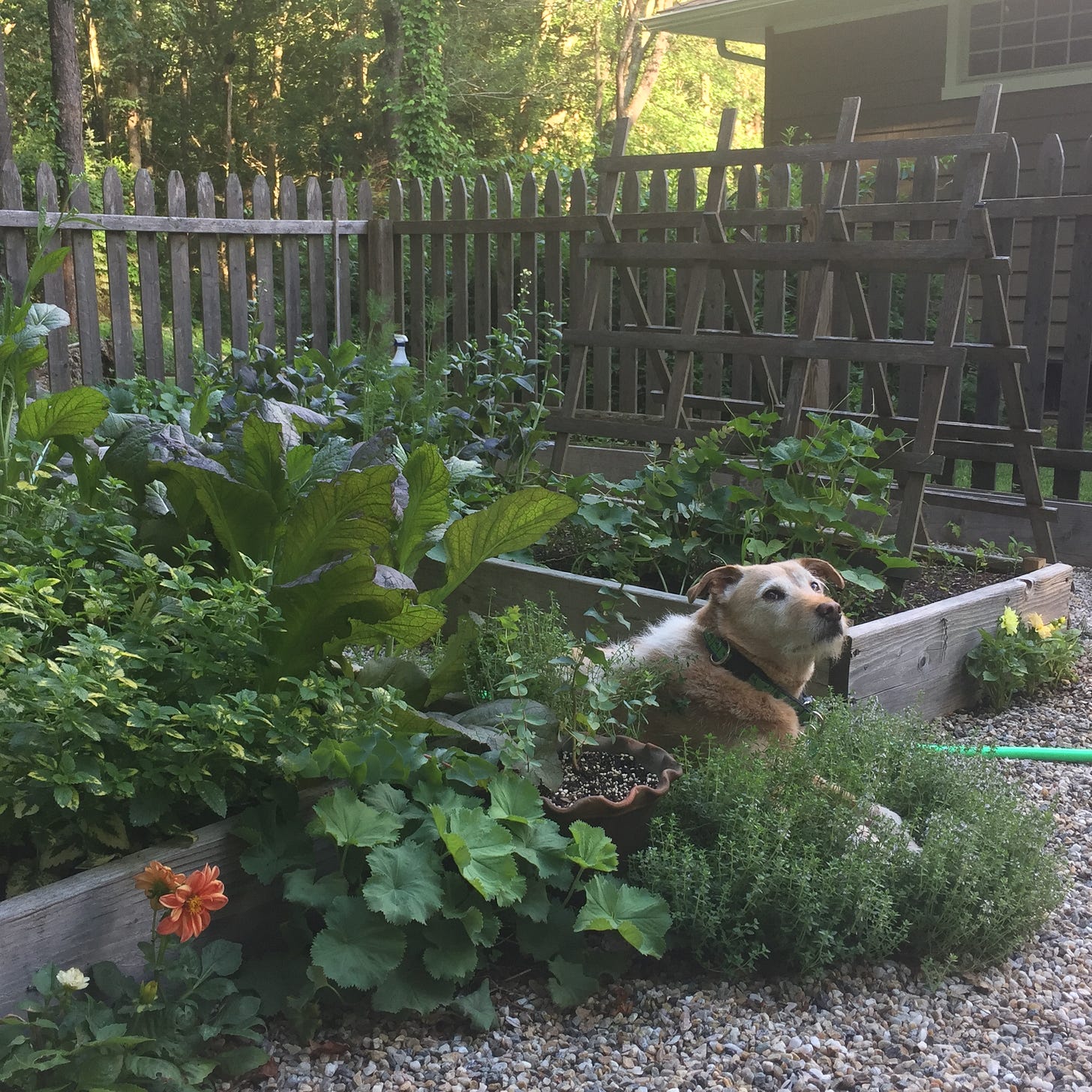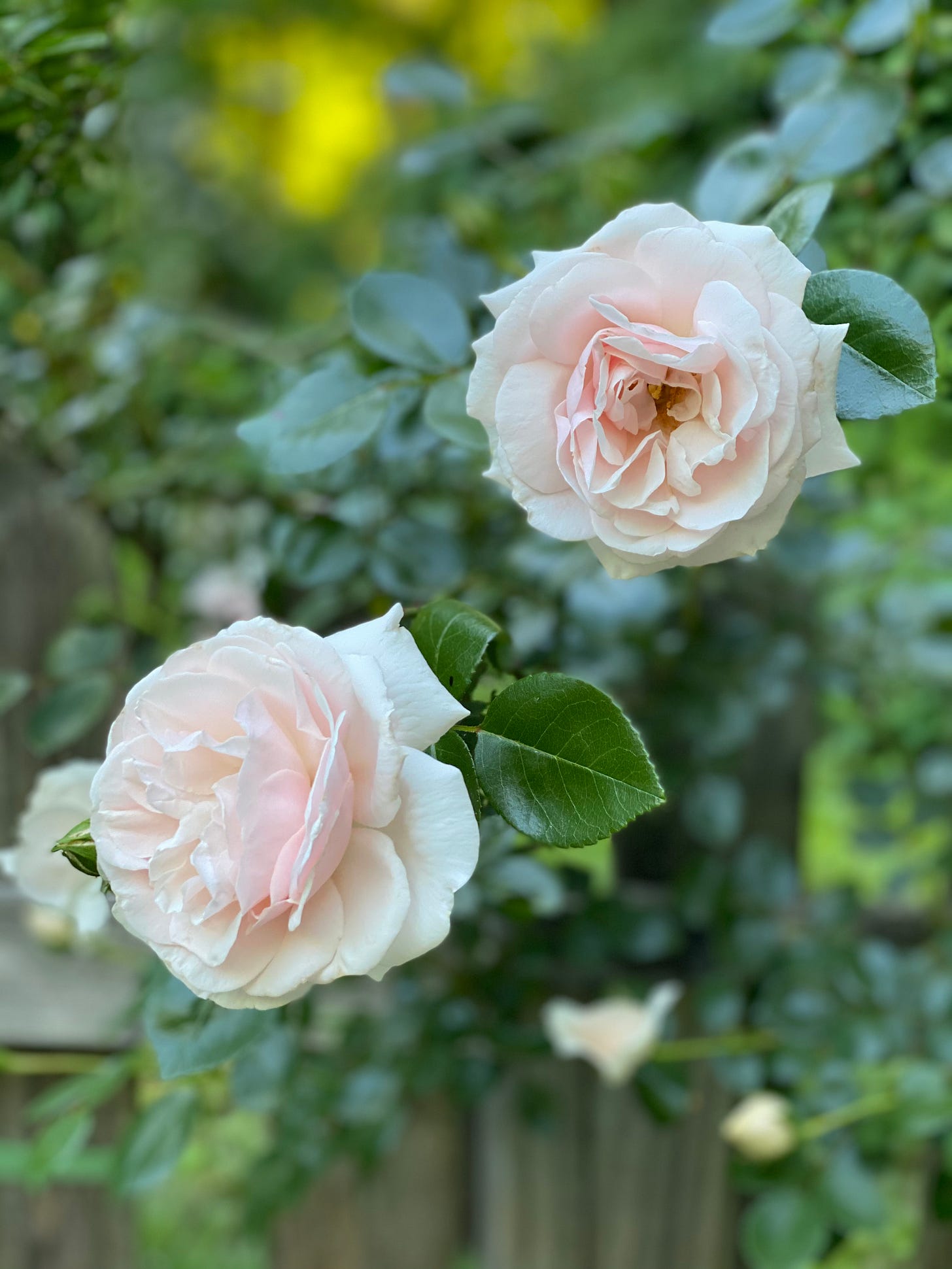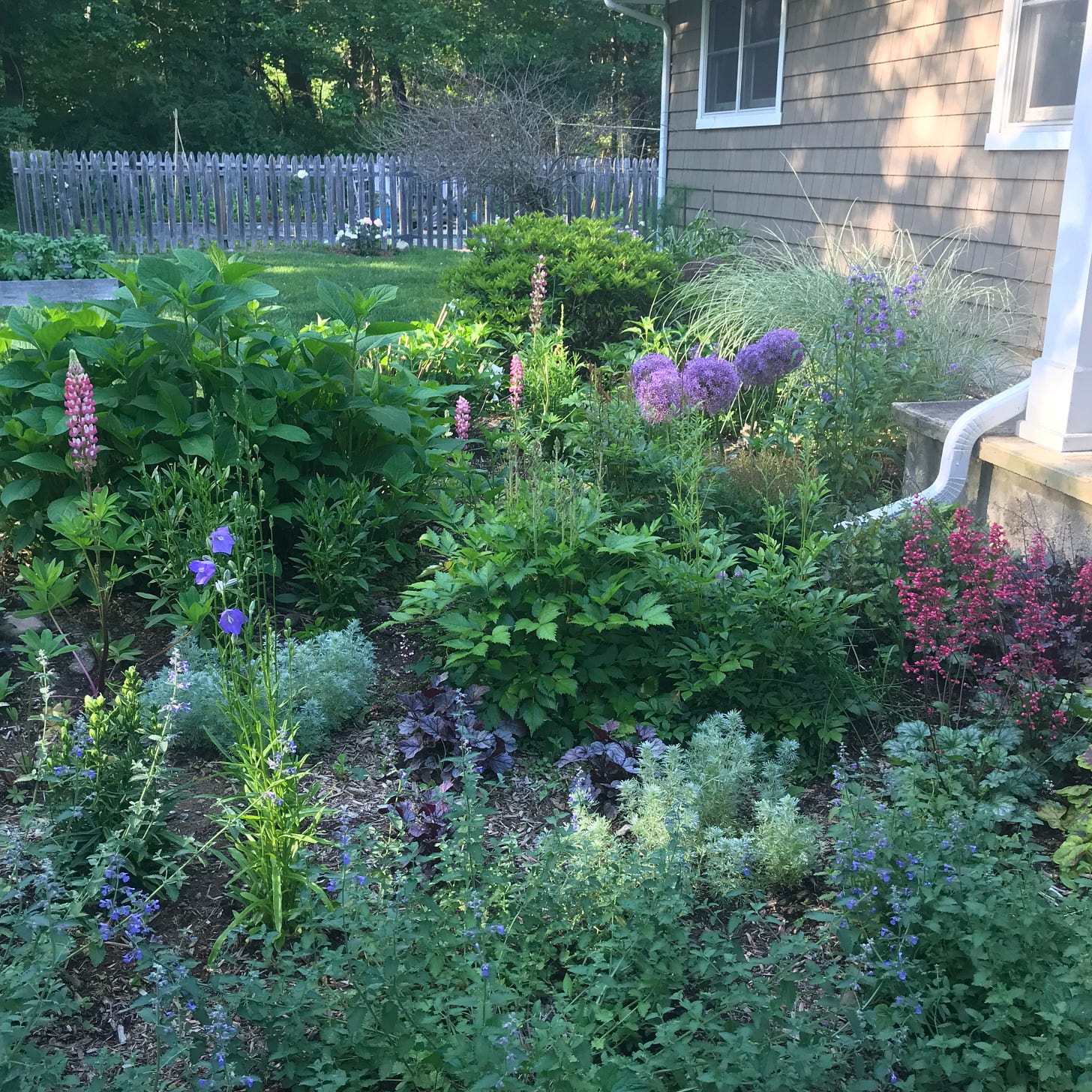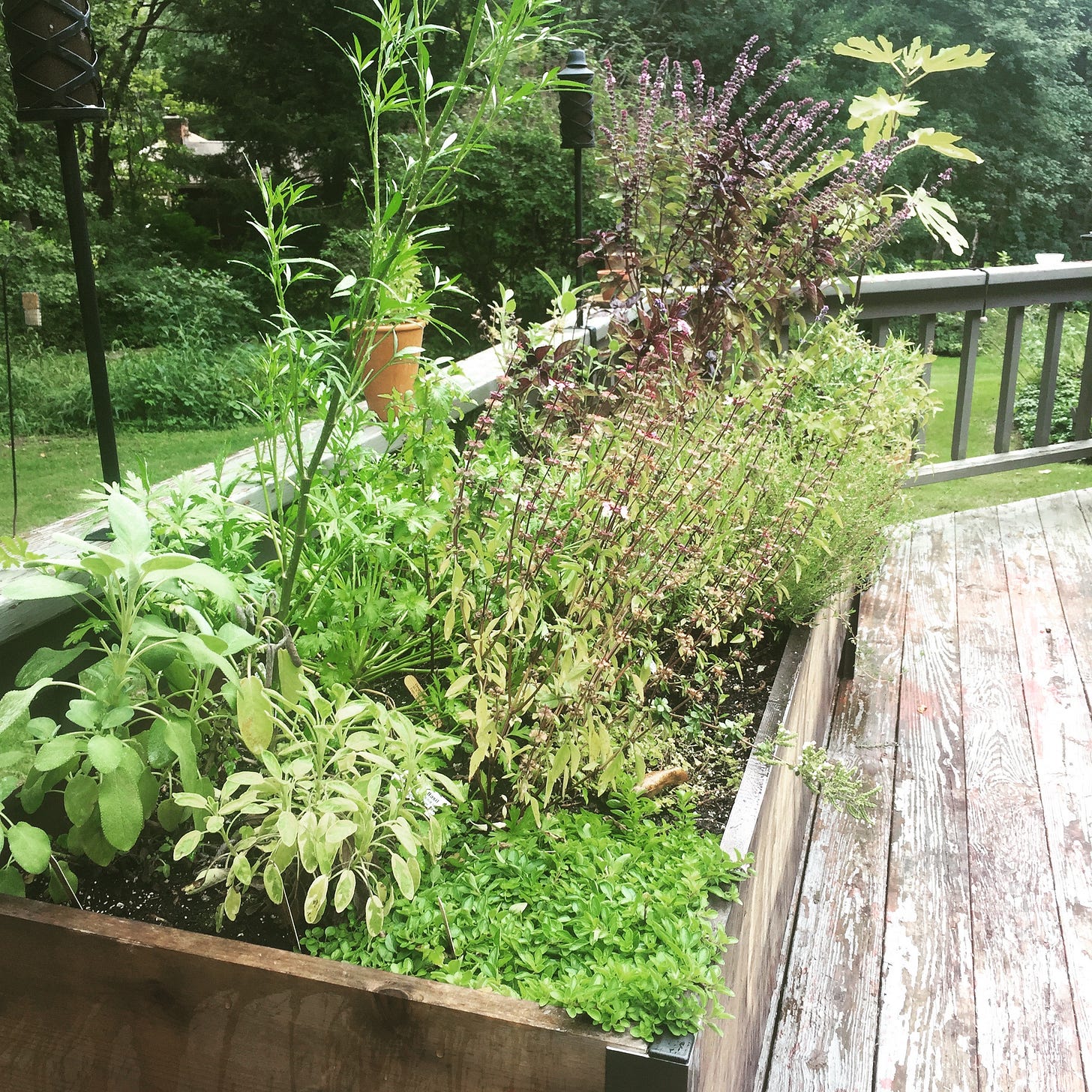My father used to tell a joke: the reason I divorced your mother was because she was too religious — every meal she made was a sacrifice or a burnt offering.
Sadly true.
My mother’s attempts at what used to be called The Domestic Arts mostly failed, although she tried and tried valiantly. Under pressure from my father, she hosted holiday dinners for twelve involving massive turkeys and standing ribs, and inevitably wound up performing for her guests instead of focusing on the food. She boiled soups until the pots were blackened and burnt. She immolated our lamb chops every week by dousing them with vegetable oil and shoving them under the broiler, resulting in angry flames licking up the front of our Chambers stove, which my grandmother then tried to beat out with a greasy kitchen towel; I attribute my lifelong pyrophobia to this ritual, although I have gotten better.
Eventually, my mother mostly stopped cooking and turned to caring for hanging houseplants, which were very popular in the 1970s, along with the brown macramé supports in which they swung from C-hooks hammered into our apartment ceiling. They all died in quick succession, mostly because she forgot to water them the way she forgot to feed my goldfish for the entire summer of 1972, when I was away at sleepaway camp for eight weeks. Also, we had limited light — our fourteen-story building was across a wide courtyard from an identical building, and our apartment was on the eighth floor — so when she brought home a spider plant (she thought it was a Wandering Jew — a Tradescantia Zebrina — which became a punchline for my very secular Anglophile father who had grown up the son of an Orthodox cantor), it lasted for maybe a month before it shriveled up and died.
I did not grow up in a family that was even remotely interested in gardening of any kind, nor did they understand why anyone would be compelled to be.
My beloved grandmother Clara lived across the street in an apartment that had been painted a deep tan — walls and ceiling — which gave the effect of being inside a cup of milky coffee; her windows, both living room and bedroom, looked out over the Long Island Railroad train tracks, and the building shuddered whenever one blew past. There was no light whatsoever — just clouds of diesel smoke wafting up to her sixth-floor apartment — so she never attempted to grow anything, although for the eighteen years that our lives overlapped, she kept an enormous bunch of pussy willows in a tall green glass vase that was shaped to mimic a tree trunk. She was a native Brooklynite who had lost her baby brother to the 1918 flu, lived through the Depression, was in a sixty year relationship with a woman and married to a man involved with a local nun; few things brought her joy, like listening to the Opry on Saturday nights and watching baseball (she had seen Babe Ruth in 1918 and cheered on Jackie Robinson in both the Negro and Major league when he went to the Brooklyn Dodgers), but growing things to her seemed frivolous — it was just not her thing, although I gather she was part of a Williamsburg, Brooklyn community who supported and planted a victory garden during the War, which my mother helped with when she was in single digits.
Having dirt under one’s nails was not seen as something to be proud of in my family, although a distant Uncle Louis on my father’s side, who was fond of wearing Peter Max ties into his nineties, was an award-winning grower of peonies, and my great Uncle Albert on my mother’s side was fanatical about roses, as was I when I first moved to the country. Other than the two of them, no one knew a secateur from a bassoon, and vegetables were things you bought in a grocery store and were limited to peas, carrots, and shrink-wrapped iceberg lettuce that was trucked to New York from the central coast of California.
So I did not grow up in a family that was even remotely interested in gardening of any kind, nor did they understand why anyone would be compelled to be. All of my Manhattan apartments were also too dark to grow anything, and flowers could be bought on every street corner and every neighborhood deli, so there was no point in my even trying. Then I moved to Connecticut in December 2000, and everything changed and changed quickly, as though I’d been struck by lightning.
I started with climbing roses — Pierre de Ronsard and New Dawn — planted up against our front fence at Susan’s Litchfield County cape, and Don Juan which was the color of my mother’s favorite lipstick that I wrote about in Motherland, and crawled up the side of the shed where we kept the mower. We then built huge vegetable boxes and grew everything we loved: lettuce, hearty greens, tomatoes, onions, cucumbers, and several different varieties of zucchini and winter squash. Being completely organic, we failed with almost every brassica we attempted and lost them all to worms. I hate beets — even gorgeous Chioggias, which I desperately want to love — so I have no memory of whether or not we ever had any success with them. We were completely unfenced and had no problem with deer, who had plenty to eat in the Litchfield hills, and left us alone.
How natural it seems to be to turn to flowers, gardens, and growing during times of grief and shock, when we rattle around our days like pebbles in a tin can, unmoored and shaken.
In front of Susan’s house was a small cottage garden planted by the previous owner; when we remembered and had time to weed it, it was lovely. When it was overtaken by vines and dandelions and knotweed, it looked like the entrance to a cave in a Grimm’s Fairy Tale. Two wooden boxes hung from the front windows, and Susan planted her mother’s favorite annual — impatiens — in colors that can only be described as cornea-burning. Susan’s mother was our wildcard: the tenth child of a subsistence farmer, she would arrive in her Buick on early summer mornings and work in our garden until late in the day, stopping only for a few vodka tonics. She could throw seeds of any kind at the ground and they would grow, and was the kind of person who would take a fancy to an ornamental something growing outside her doctor’s office, surreptitiously snip off a little, stick it in her garden, water it, and have a shrub a year later.
My friends from the city laughed at this person I’d become, surrounded on the couch by piles of Kitchen Gardener, Fine Gardening, and Garden Design, and shaded by stacks of massive gardening encyclopedias. I couldn’t figure out how or why this was happening, and neither could anyone else, but now I know: in 2002, on a hot August morning when Susan and I were in the garden, up to our ankles in soil and compost, my father and stepmother, two hours away on Long Island and running an errand, were t-boned by a bunch of kids driving a rusted-out Toyota. After the accident, my stepmother was taken to one hospital and he to another; they never saw each other again. My stepmother’s injuries were severe, but she thankfully survived. My father, succumbing to a massive brain injury, lingered for a week with every organ failing, until I removed him from life support. Almost instantly, while having to deal with the practical facts of his accident — the insurance papers, the unspeakable task of identifying his car, which Susan took upon herself — a family member I had once been extraordinarily close to turned on me in a way that can now only be described as comical. There was the grief over losing the parent who arguably had saved my life and without whom I would not be sitting here writing this; there was the grief over losing someone else who had been like a sibling and who, on the morning before my father’s funeral, asked for the key to her house back.
It is true what the wise Clover Stroud says in her extraordinary piece on grief: Grief will change your life completely, in ways you could not anticipate, altering familiar family landscapes, and changing the shape of your closest relationships.
After I got over the initial hump of grief, when nothing whatsoever seemed to have any meaning, I began to want to have my hands in the dirt and under my nails; I wanted to create beauty and texture and structure where it had been lost for me.
In the months and years that followed my father’s accident, I became obsessed with gardening and cooking. This is not exceptional: the things that bring color, texture, and sustenance to one’s life naturally start to take precedence during times of such profound sorrow, which, if one were to attempt to describe them, are ineffable. When there are no words, we look for solace in ritual and process; we wake up, we make the coffee, we make the tea, we walk the dog because these are the things that steady us, that provide foundation. After I got over the initial hump of grief, when nothing whatsoever seemed to have any meaning, I began to want to have my hands in the dirt and under my nails; I wanted to create beauty and texture and structure where it had been lost for me.
In Molly Peacock’s The Paper Garden: An Artist Beings Her Life’s Work at 72, the author recounts the story and work of Mary Delany, who, in the 18th century and shortly after her second husband’s death, began to create 985 botanically-correct, cut paper flower mosaics, which are now housed in the British Musem. Peacock writes,
When Mrs. D picked up her scissors, grief was the chief prompt. After her beloved Dean Delany’s death in 1768, which followed the death of her sister, Anne, in 1761, she wrote that she considered each of her flower portraits to be ‘an employment and amusement, to supply the loss of those that had formerly been delightful to me….’
In her Substack, Sarah McCraw Crow writes at length about Mary Delany, author Molly Peacock, and The Paper Garden. As I read Crow’s essay and dipped in and out of this extraordinary book, I found myself here, thinking about how natural it seems to be to turn to flowers, gardens, and growing during times of grief and shock, when we rattle around our days like pebbles in a tin can, unmoored and shaken.
Gardening, it seems, is a human response to grief.
So why now? Why are gardening, garden design, garden narrative, garden tours, and gardeners (famous and not) suddenly showing up everywhere, from social media to the New York Times, from Netflix to Substack, from podcasts and the hallways of book publishing (where I was regularly told, as an acquiring editor, that gardening books don’t sell)? Because I believe we are a grief-stricken culture that has watched beauty, safety, and common decency be radically subjugated before our very eyes. We have witnessed grave change to an imperfect world, where we took what we thought was a given — democracy — and watched it be turned upside down, as my grandparents warned me might happen someday. Don’t get too comfortable, my grandmother would tell me; I thought she was crazy.
Gardening, it seems, is a human response to grief.
In 2012, ten years after my father’s death, I became the editorial director of Rodale Books in New York, with a focus on bringing both food and gardening books to the general public; cookbooks had been popular for generations, but gardening books hadn’t, at least not in the States, and I was charged with finding out why, and changing it. In December of that year, my small New England community of Newtown, Connecticut, experienced devastating gun violence when a young, severely mentally ill man with access to military-grade automatic weapons murdered twenty of my neighbors’ children between the ages of six and seven, and six adult staff members. Rodale, led by Maria Rodale, responded with an offer of trees, representing life and hope. A community vegetable garden sprang up across town. My neighbors began planting everything they could, anywhere they could. A massive storm forced us to remove five splintered trees from our property; we had the area graded, and Susan and I sat together in the dirt and built six 8-foot by 3-foot vegetable boxes bordered by a perennial bed. We added pea gravel (a bad idea) and Adirondack chairs and created an outdoor room within the garden. It was the only place we wanted to be, even as our vegetables often failed and our flowers often died, and the weeds became impossible to cope with. It’s been thirteen years, and the garden still exists and is now a complete mess; we’re trying to decide what’s next for it, as the boxes are disintegrating, and we, and our backs, have gotten older and creakier.
In lockstep with a world that has grown very dark, gardens and gardening are ubiquitous. While it has always been a part of British, European, and Asian vernacular, it has not been to the same extent here in the States, despite the work of McKim, Mead, and White, Gertrude Jekyll (who was commissioned to create the gardens at Glebe House in my local Woodbury, Connecticut, among others), Katharine White, Eliot Coleman and Barbara Damrosch, Ellen Ecker Ogden, Margaret Roach, Katherine Whiteside, The Rodale Institute, and many others. But here we are, with hundreds of garden designers populating social media and Substack, and American devotees of Monty Don, Nigel Slater, Olivia Laing, and Derek Jarman are everywhere. It seems that with every passing day, more and more of us are turning to the earth, to dig our hands deep into the soil as a way to beat back uncertainty and the anguish that comes with knowing exactly how dangerous and cruel our world has become before our eyes.
As for me, beyond the fact of my country’s political state, I am now facing the work of caring for my irascible, chronically enraged mother as she moves into her last years, a fact I’ve written about extensively. I come home to Connecticut from my days seeing her in New York, witnessing her decline and profound loneliness, and coping with her simultaneous filterless rage that is always directed at me, and all I do is imagine the possibility of beauty and texture, of growing something from nothing. I refuse to wait for the things I plant to just die, the way her spider plant did back in the 1970s, swinging from the ceiling in its macrame snood. Instead, I look for inspiration everywhere, and when I realized that the trip Susan and I are taking in a few weeks to England and Scotland is essentially amounting to a tour of gardens — Sissinghurst, Great Dixter, Chelsea Physic, and Derek Jarman’s Prospect Gardens — it made perfect sense to me, and it will be one of the greatest gifts I’ve ever received: my hands and my heart will be grateful, as ever.
I suspect I will come home to my house and garden, grab my trowel and my Felcos, and dig.
I am including a list of some of my favorite garden writers, gardens, gardeners, designers, and publications below. Please feel free to add to it in comments.












This piece is a drink of cool water as sweet as the first peas of the growing season. Gardening is a balm and an incentive to keep believing in tomorrow. 💚
Anything and everything from Erin Benzakein at www.floretflowers.com.